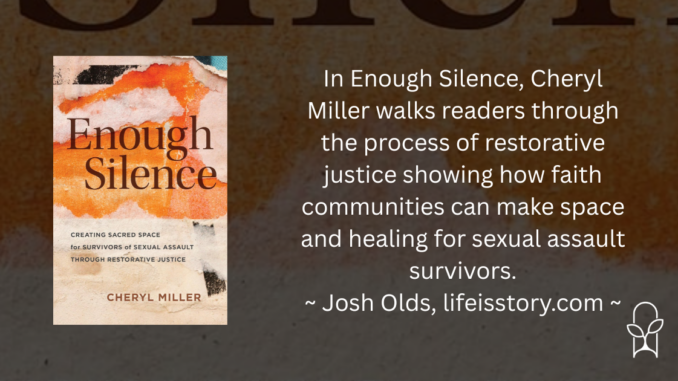
Published by Eerdmans on July 23, 2024
Genres: Non-Fiction
Buy on Amazon
Goodreads

Learn how restorative justice can offer healing to survivors of sexual abuse in your faith community
Clara was five years old the first time she was raped by her father. The trauma stifled Clara’s self-esteem, ability to trust others, and emotional regulation well into adulthood. But after an encounter with a repentant man who had committed the same crime against his own daughter—through a guided victim-offender dialogue—Clara was finally able to breathe.
In Enough Silence, Cheryl Miller draws on more than two decades working with survivors of abuse to create the composite character of Clara. Her story represents countless real people in our faith communities living with a personal history of sexual trauma. Clara’s story illustrates how restorative justice practices—implemented with care—can transform the lives of survivors. These practices include
• holding offenders accountable,
• lending direct voice to survivors, offenders, and members of the community,
• taking into account all those with stakes in incidents of sexual abuse,
• clarifying the organization’s values, and
• establishing a safe and structured environment for survivors.
She also offers a road map for implementing victim-offender dialogue, surrogate dialogue, circles, and more.Enough Silence issues a call to pastors, clergy, nonprofit professionals, and other leaders to dismantle patriarchal systems that perpetuate rape culture. By embracing restorative justice practices, faith communities can imitate Christ in ministering to survivors and those who love them.
1 out of every 6 American women and 1 out of every 33 American men have been the victim of an attempted or completed rape in their lifetime. Everyone is impacted by sexual assault. And as horrific as these numbers are, sexual violence has actually been halved over the last twenty years. We’ve come a long way on the journey toward protection, now we must take control of healing. In Enough Silence, Cheryl Miller walks readers through the process of restorative justice showing how faith communities can make space and healing for sexual assault survivors.
Enough Silence is based on Miller’s decades of work in mediation and restorative justice. At the heart of the book is Clara—a composite character based on a number of real-life people under Miller’s care—who struggles as an adult with the effects of her childhood sexual assault. This fictionalized narrative brings a stirring reality to how restorative justice works, moving from theoretical blueprint to experiential reality. It’s a story that’s often uncomfortable (Miller provides trigger warnings when needed), but reflects a harsh reality. Enough Silence refuses to be silent and instead gives voice to victims and makes public the evil of sexual assault with the purpose of motivating others to be a part of both prevention and healing.
In the first part of Enough Silence, Miller explains the restorative justice process. First, victims must have a direct voice in the process. In legal (retributive) justice, the victim’s voice is often secondary. Restorative justice enables victims to tell their story and be a part of deciding how that harm can be repaired. Second is stakeholder focus. This is a focus on those who have been impacted by the injustice. Instances of abuse create secondary traumas to those not directly impacted by the abuse.
Third, perpetrators must be held accountable for their actions. One of the most interesting parts of Enough Silence was its explanation of programs like Making it Right, which facilitates victim-offender dialogue in scenarios were repentant offenders want to seek forgiveness and make reparations. This is an incredible difficult and crucial part of the process and we can often forget—or want to forget—that offenders themselves are in need of healing. This does not exempt them from punishment or downplay the evil of their actions, but acknowledges their need for repentance.
Fourth is clarity of values. Understand the beliefs that motivate people help reconcilers find the areas in which healing can best be facilitated. Then, fifth, is maintaining a safe/structured environment. This means ensuring that the way in which restorative justice is attempted is in such a way that does actually bring out safety and healing.
The rest of Enough Silence continues to blueprint the restorative justice process, helping churches and faith communities realize the complexity and necessity of restorative justice for healing. I appreciate that Miller also takes readers into the self-concept of offenders, not justifying or condoning their behavior, but helping readers understand the context of sexual abuse and the humanness of the offender. Understanding this perspective enables justice and restoration to also work on the heart of the offender.
I want to be clear that although Enough Silence is an overview of the restorative justice process in the context of sexual abuse, simply reading this book does not qualify individuals or churches to engage in the process. When you don’t know what you are doing, you will do more harm than good. In the name of restoration, churches have often encouraged victims to forgive their abusers, placed victims in uncomfortable positions with their abusers, or attempted to fast-track restoration in order to cover-up abuse. That is not restorative justice. Enough Silence is meant to highlight the process so that those interested can move forward into actual training for the intense work that is facilitating such a thing. It is hard work, but it must be done. Enough Silence shows us that it can.
